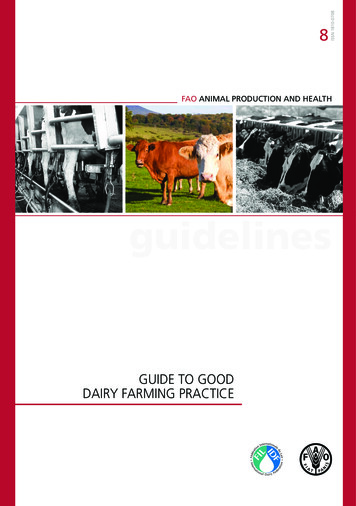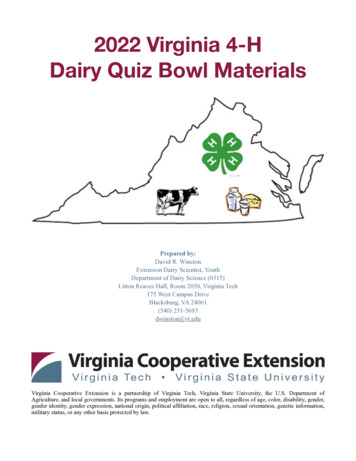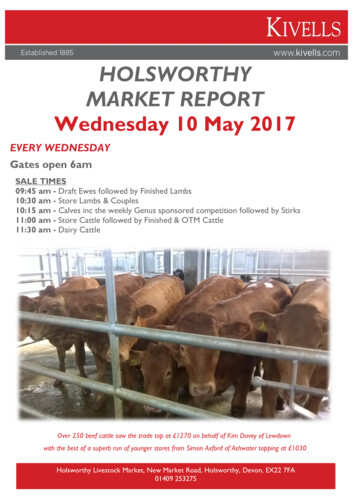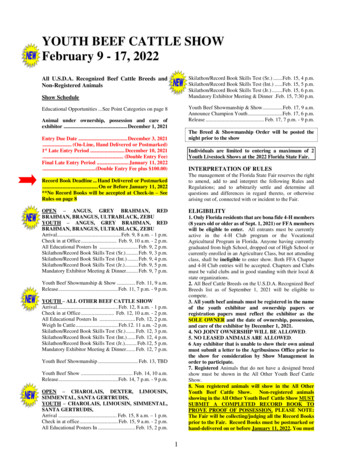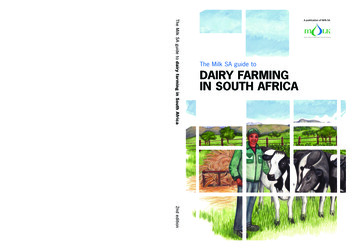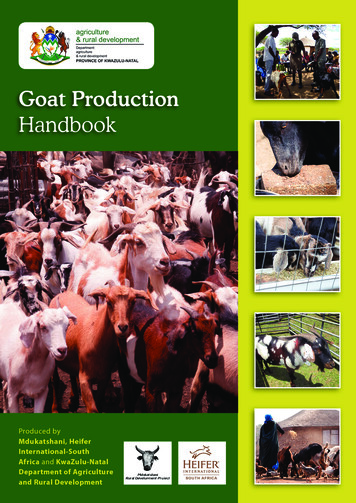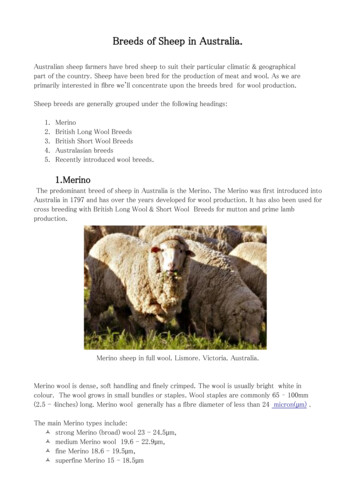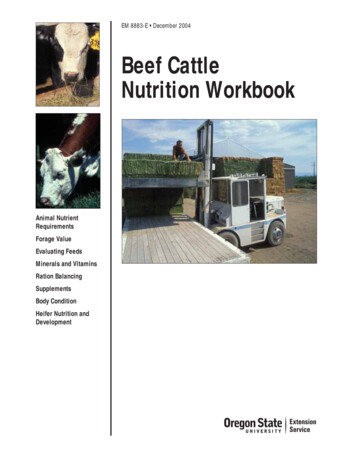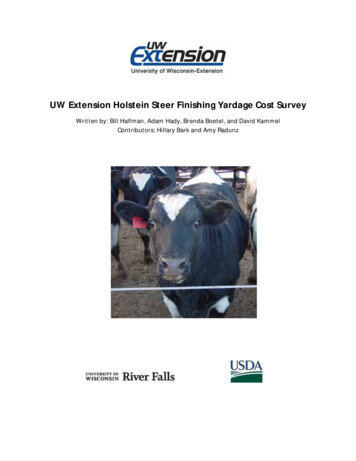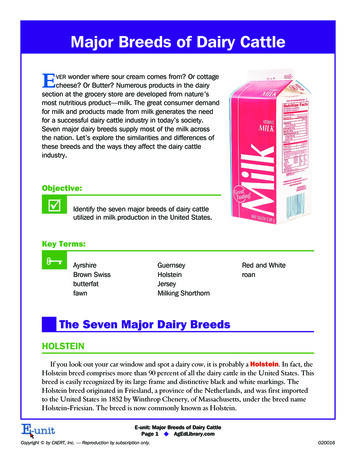
Transcription
Major Breeds of Dairy CattleEVER wonder where sour cream comes from? Or cottagecheese? Or Butter? Numerous products in the dairysection at the grocery store are developed from nature’smost nutritious product—milk. The great consumer demandfor milk and products made from milk generates the needfor a successful dairy cattle industry in today’s society.Seven major dairy breeds supply most of the milk acrossthe nation. Let’s explore the similarities and differences ofthese breeds and the ways they affect the dairy cattleindustry.Objective:þIdentify the seven major breeds of dairy cattleutilized in milk production in the United States.Key Terms:ÑAyrshireBrown SwissbutterfatfawnGuernseyHolsteinJerseyMilking ShorthornRed and WhiteroanThe Seven Major Dairy BreedsHOLSTEINIf you look out your car window and spot a dairy cow, it is probably a Holstein. In fact, theHolstein breed comprises more than 90 percent of all the dairy cattle in the United States. Thisbreed is easily recognized by its large frame and distinctive black and white markings. TheHolstein breed originated in Friesland, a province of the Netherlands, and was first importedto the United States in 1852 by Winthrop Chenery, of Massachusetts, under the breed nameHolstein-Friesian. The breed is now commonly known as Holstein.E-unit: Major Breeds of Dairy CattlePage 1 u AgEdLibrary.comCopyright by CAERT, Inc. — Reproduction by subscription only.020016
A Holstein dairy cow willmature to about 1,500 pounds andproduce an average of 24,876pounds of milk per year. Thisbreed’s advantage of high milkproduction makes it the largestmilk producer of all the dairybreeds. Yet, this breed’s milk islow in butterfat (the fat contentin milk) and protein. This lack ofbutterfat and protein is a disadvantage to the producer becausethe milk is classified as a lowquality product and receives alower premium.FIGURE 1. Holstein. (Courtesy, Pete’s Photo, Wykoff, MN)RED AND WHITEBecause of their qualitativegenetic traits, Holstein dairy cattleevolved to develop another dairycattle breed, the Red and White.When Holsteins carrying the redrecessive traits are bred, this breedemerges and holds characteristicssimilar to those of the Holsteinbreed, except for a difference incolor markings. The Red andWhite breed has red and whitemarkings. Years ago, Holsteinproducers would cull red-coloredHolsteins because the animalswere not eligible for registration.It was not until 1966 that thesecattle could be registered as abreed.FIGURE 2. Red and White. (Courtesy, Pete’s Photo, Wykoff, MN)AYRSHIREThe Ayrshire breed of cattle is widely known for its “vigorous personality,” with its strongfeet and legs, excellent ability to withstand extreme temperatures, and strong, well-attachedE-unit: Major Breeds of Dairy CattlePage 2 u AgEdLibrary.comCopyright by CAERT, Inc. — Reproduction by subscription only.020016
udders. Because of this vigor,Ayshires have a superior grazingability, which allows for the consumption of forages for a higherquality of milk production.The Ayrshire breed has a variety of colors, including light todeep cherry red, mahogany,brown, a combination of thesecolors with white, and solidwhite. This breed has a mediumsized frame. An Ayrshire cowmatures to about 1,200 pounds,and yields more than 17,000pounds of milk, on average.FIGURE 3. Ayrshire. (Courtesy, Pete’s Photo, Wykoff, MN)The breed originated in theCounty of Ayrshire in Scotlandand was first imported to the United States in 1822 by a dairy farmer in Connecticut to grazeon rocky pastures. The majority of Ayrshire cattle grown in the United States today can befound in New York, Wisconsin, and Pennsylvania.BROWN SWISSThe Brown Swiss is one of the oldest breeds of dairy cattle, with records dating back to4000 B.C. Originating in the Alps of Switzerland, Brown Swiss cattle were first imported to theUnited States in 1869 byHenry M. Clark, of Balmont,Massachusetts. Because of thisbreed’s ability to adapt to variousenvironments and stress, itquickly spread throughout thenation, reaching the Pacific Coastin 1895.Mostly covered in shades oflight to dark brown, the BrownSwiss breed is known for its blacknose, tongue, and tail and itslightly colored band around themuzzle. With a calm disposition,the Brown Swiss is a slow-maturing breed that has correct feet andlegs. It is classified as a largeFIGURE 4. Brown Swiss. (Courtesy, Pete’s Photo, Wykoff, MN)framed breed, with a BrownE-unit: Major Breeds of Dairy CattlePage 3 u AgEdLibrary.comCopyright by CAERT, Inc. — Reproduction by subscription only.020016
HELPTANWEDON THE JOB CAREER CONNECTION:Communications Director of a Breed AssociationDo you enjoy being with animals and like to socialize? Then you should consider pursuing acareer as the communications director of a breed association in the dairy cattle industry. Thisperson is responsible for being the voice of stakeholders concerned with the future of the breedand its relationship to the agricultural industry. In addition, the communications director mustconvey a vision for the future of the breed’s genetics to the dairy cattle industry as well as toproducers. To represent a breed association, a communications director needs to have strongverbal and written communication skills, experience in the dairy cattle industry, and a bachelor’sdegree in agricultural communications or animal science. This career may require extensivetravel while serving as a spokesperson for the dairy cattle industry. Salaries for this career rangefrom 30,000 to 45,000 per year.Swiss cow, on average, maturing to 1,500 pounds, while yielding more than 20,000 pounds ofmilk. The Brown Swiss breed is distinguished for its longevity and a persistent milking ability.The milk has a high butterfat and protein ratio compared with the milk of other breeds.Researchers using biotechnology are making strides to improve Brown Swiss udder qualityand milk yield.GUERNSEYThe Guernsey, often referredto as the “Golden Guernsey,” iswell known for the color of itsmilk, which is more golden thanthe milk of other breeds of dairycattle. Because of the off-color ofits milk, the Guernsey breed hasbecome less popular with consumers, resulting in a decline inthe numbers of this breed. Developed by monks, the Guernseybreed originated on the Island ofGuernsey, France. Its first importation to the United States byCaptain Belair arrived in NewYork in 1840.FIGURE 5. Guernsey. (Courtesy, Pete’s Photo, Wykoff, MN)E-unit: Major Breeds of Dairy CattlePage 4 u AgEdLibrary.comCopyright by CAERT, Inc. — Reproduction by subscription only.020016
The Guernsey is usually fawn, or orangish-brown, with various white markings and a clearmuzzle. It is classified as a medium-framed animal. The average Guernsey cow matures to1,100 pounds and produces more than 16,000 pounds of milk. Guernseys produce a milk thatis high in fat and protein. Because of their small calves and low feed consumption, Guernseysare not able to compete against other breeds in the dairy industry market.JERSEYThe Jersey breed’s popularity has increased in recent years due to its production of milkwith the highest fat and protein content of all dairy cattle breeds. In fact, the Jersey is oftencalled the “cheese breed” because of the high yield of cheese from its milk. On average, a Jersey cow matures to 950 pounds but produces more than 17,000 pounds of milk. With its smallsize and high milk yield, the Jersey breed is the most efficient producer in the world.The Jersey is usually fawn in color but can have a variety of white markings or be almostcompletely black. Often, the Jersey has a white ring above its nose and has black hooves and ablack nose.Jersey cattle are known for their ability to adapt to a wide range of geographic and temperature conditions. Originating on the British Island of Jersey and imported to the United Statesin 1850, the Jersey breed is widely spread throughout the world.FIGURE 6. Jersey. (Courtesy, Pete’s Photo, Wykoff, MN)MILKING SHORTHORNThe Milking Shorthorn was identified as a dairy breed of cattle in 1968. Originating inTee River Valley, England, the Milking Shorthorn was first imported to the United States in1793, arriving in Virginia as both a beef- and milk-type animal.E-unit: Major Breeds of Dairy CattlePage 5 u AgEdLibrary.comCopyright by CAERT, Inc. — Reproduction by subscription only.020016
Milking Shorthorns are usuallycharacterized by various colors,such as shades of red, red andwhite, solid white, or roan,meaning a reddish-white color.Milking Shorthorns are known asmedium-framed animals withdeep bodies and straight legs. Onaverage, Milking Shorthorn cowsmature to 1,250 pounds and yieldmore than 17,000 pounds of milk.This breed is characterized as typically having great calving ease,good grazing ability, and largeudders. Due to genetic improvements in recent years, the MilkingShorthorn breed has becomemore viable with an improvedudder quality.FIGURE 7. Milking Shorthorn. (Courtesy, Pete’s Photo, Wykoff, MN)Summary:2The seven major dairy breeds of cattle are viable to the success of the dairy industrybecause of their illustrious traits. The Holstein breed is known for its large averagemilk production but is at a disadvantage because of the low butterfat and proteincontent of its milk. The Red and White breed is very similar to the Holstein exceptfor its coloring. The Ayrshire breed is well known for its strong feet and legs, grazing ability, and well-attached udders. The Brown Swiss breed is distinguished by itshigh fat and protein ratio of its milk and its calm disposition. The Guernsey breedoften has smaller calves and produces golden-colored milk. The Jersey breed produces milk with a high butterfat and protein content. The Milking Shorthorn is adual-purpose breed; that is, it is both a meat- and milk-type breed.Checking Your Knowledge: 1. What dairy breed produces the majority of milk in the United States today?2. What dairy breed is classified as one of the oldest breeds?3. What breed of dairy cattle produces milk that is slightly more golden in colorthan that of other breeds today?4. What breed of dairy cattle is characterized as the most efficient producer in theworld?5. What breed of dairy cattle is characterized as a dual-purpose breed?E-unit: Major Breeds of Dairy CattlePage 6 u AgEdLibrary.comCopyright by CAERT, Inc. — Reproduction by subscription only.020016
Expanding Your Knowledge:LExplore the Internet by searching for the seven major dairy cattle breeds. Investigateeach breed and discover whether each breed has a breed association. List the advantages and disadvantages breed associations have for a dairy cattle producer.Web Links::Ayrshire Breeders Associationhttp://www.usayrshire.comBrown Swiss Associationhttp://www.brownswissusa.comAmerican Guernsey Associationhttp://www.usguernsey.comHolstein Associationhttp://www.holsteinusa.comAmerican Milking Shorthorn Societyhttp://www.milkingshorthorn.comAmerican Jersey Cattle Associationhttp://www.usjersey.comRed and White Dairy Cattle Associationhttp://www.redandwhitecattle.comE-unit: Major Breeds of Dairy CattlePage 7 u AgEdLibrary.comCopyright by CAERT, Inc. — Reproduction by subscription only.020016
found in New York, Wisconsin, and Pennsylvania. BROWN SWISS The Brown Swiss is one of the oldest breeds of dairy cattle, with records dating back to 4000 B.C. Originating in the Alps of Switzerland, Brown Swiss cattle were first imported to the United States in 1869 by Henry M. Clark, of Balmont, Massachusetts. Because of this

